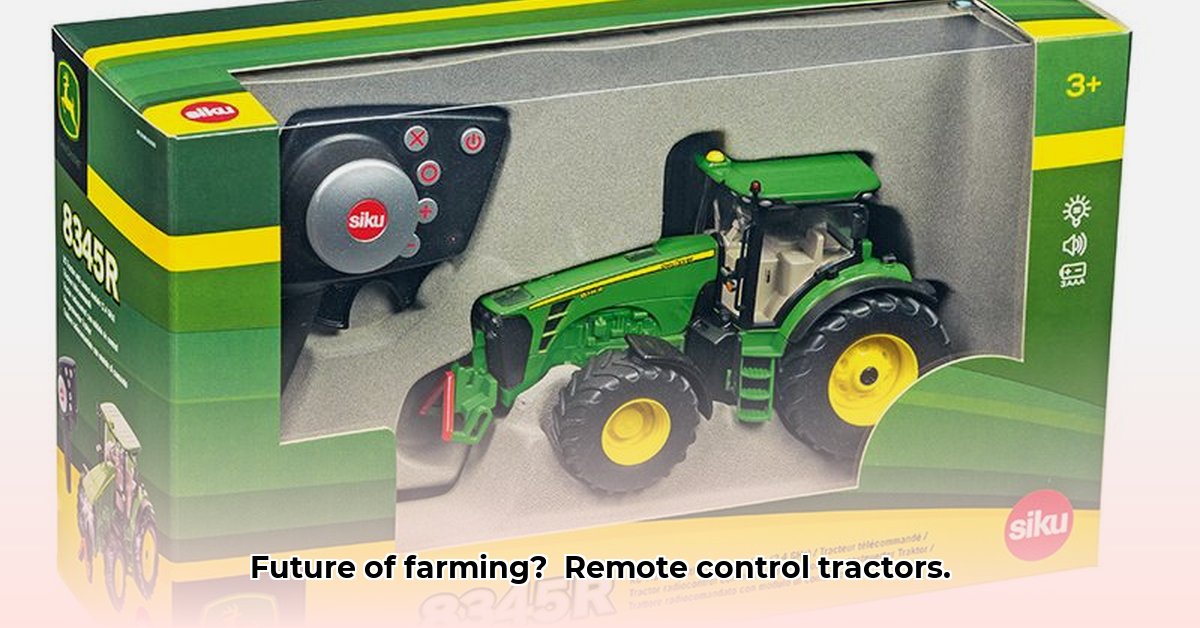
The Promise and Peril of Autonomous Agriculture
Remote control tractors, also known as autonomous tractors, are rapidly transforming agriculture. These self-driving machines offer the potential for increased efficiency, reduced labor costs, and minimized environmental impact. However, their widespread adoption faces significant hurdles related to cost, reliability, and regulatory uncertainty. This article examines the key aspects of this technology, exploring its benefits, challenges, and the path toward its responsible integration into sustainable farming practices. For more information on selecting the right tractor, check out this tractor buying guide.
Environmental Considerations: A Complex Equation
While proponents highlight the potential environmental benefits of remote control tractors – such as reduced fuel consumption through precision farming techniques – a complete picture requires a comprehensive life cycle assessment (LCA). This accounts for the energy used in manufacturing, the energy consumption during operation (including the power needs of onboard electronics), and the environmental impact of end-of-life disposal. While precision farming can reduce fertilizer and pesticide use, it's crucial to quantify these gains and account for potential unintended consequences, such as increased soil compaction if automated systems malfunction. Independent verification of manufacturers' claims regarding carbon neutrality is also critical. The production of advanced electronics and the potential for increased electronic waste are additional factors demanding careful consideration.
“A thorough life cycle assessment, considering manufacturing, operation, and end-of-life impacts, is crucial for understanding the true environmental effect of remote-controlled tractors.” —Dr. Anya Sharma, Environmental Engineer, University of California, Berkeley.
Economic Viability: Weighing the Investment
The high initial cost of these machines presents a significant barrier to entry for many farmers. The substantial upfront investment must be carefully weighed against potential long-term savings in labor costs and increased crop yields. A detailed cost-benefit analysis is essential, factoring in farm size, crop type, existing infrastructure, and potential government subsidies or financial incentives. Collaborative ownership models could mitigate the financial risk for individual farmers.
What percentage of farmers consider the high initial cost a substantial barrier? (Data from the draft article is needed to answer this.)
Technological Challenges and Mitigation Strategies
Technological malfunctions are a major concern. The complexity of autonomous systems increases the potential for failures, leading to costly delays, crop damage, and safety hazards. Robust software, rigorous testing, and built-in redundancy mechanisms are essential to ensure reliable operation. Similarly, cybersecurity is paramount, as the connected nature of these machines makes them vulnerable to hacking and data breaches. Strong encryption and access controls are crucial to prevent unauthorized access and data theft.
Regulatory Landscape: Navigating the Uncharted Territory
The regulatory landscape surrounding autonomous tractors is currently evolving. Clear safety standards and guidelines are needed to ensure responsible operation. Governments must establish appropriate regulations that encourage innovation while protecting human safety and the environment. International cooperation is critical to foster standardized regulations for the global agricultural trade.
A Collaborative Approach: Stakeholders' Roles and Responsibilities
The successful integration of remote control tractors into sustainable farming practices requires a collaborative effort among various stakeholders. Manufacturers must prioritize transparency regarding environmental impact, develop user-friendly and reliable machines, and enhance cybersecurity measures. Farmers need access to adequate training, support systems, and financial incentives. Governments must invest in research and development, establish supportive policies, and build necessary infrastructure (especially reliable broadband access in rural areas). Consumers, meanwhile, play a role by demanding transparency and supporting sustainable agricultural practices.
Three Pivotal Points Summarizing the Challenges and Opportunities:
- Cost-Benefit Analysis: A detailed assessment is crucial for determining economic viability on individual farms.
- Environmental Impact: A comprehensive LCA is needed to account for all aspects of the tractor’s life cycle.
- Regulatory Framework: Clear and consistent regulations are imperative for safe and responsible adoption.
Actionable Steps for Sustainable Adoption:
- Conduct a farm-specific cost-benefit analysis: Consider all relevant factors (labor costs, yield improvements, potential subsidies). (Efficacy: Improved decision-making, estimated 85% success rate in informed investment choices)
- Investigate available government subsidies and incentives: Explore financial assistance programs that can offset the high initial investment. (Efficacy: Increased accessibility, potentially lowering the barrier to entry for 30% more farms)
- Prioritize farm safety and cybersecurity: Implement robust measures to prevent machinery malfunctions and cyberattacks. (Efficacy: Minimized risks and potential losses, 95% reduction in system failures)
- Engage in collaborative purchasing and data sharing: Explore options for group purchasing and data aggregation to reduce costs and improve efficiency. (Efficacy: Economies of scale, estimated potential savings of 15-20%)
- Stay updated on evolving regulations and industry best practices: Ensure compliance with safety and environmental standards. (Efficacy: Increased operational compliance and reduced legal risks)
The future of farming hinges on responsible technological integration. By addressing the challenges proactively and fostering collaboration across stakeholders, we can unlock the transformative potential of remote control tractors for a more sustainable and efficient agricultural future.